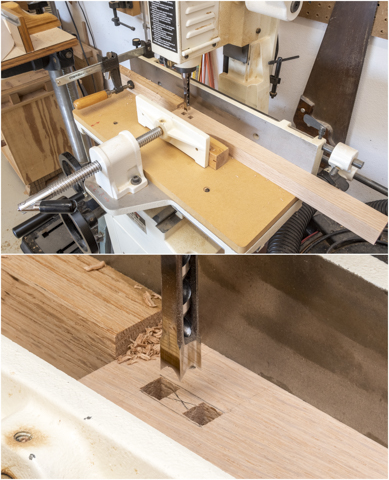Assembly and glue-up is next. Here are all the parts and pieces set up and
ready to go along with the clamps that will be used.
This is a little closer view. I am using a Type III waterproof glue not
because I need the joint to be waterproof but because the working time with it
is a little longer than the regular glue and I think that I will need every bit
of it. The folded playing cards will be
used as my “brush” to spread the glue.
As a preventative aid to make sure all the pieces go in the right places
facing the right directions the tenons as well as the mortises are all
labeled. Since the tenons are not
centered accidently reversing or flipping one would fit but would make for a
real problem.
After a frantic 10 minutes here is the seat all glued
together. Everything came together
straight and square with all four legs sitting flat on the bench.
To help lock the tenon in the mortise I used a pneumatic
pin nailer to add a one inch long nail from the inside face of the leg through
the tenon then continuing on into the far side of the leg. They are very thin and almost disappear. I think that when the piece is finished, they
will be invisible but then to find them you will have to turn the seat upside
down.
Applying the India Ink is next and it’s fairly easy to
do. A piece old cotton t-shirt about 2”
square is dipped in the jar then rubbed into the oak making sure the pores get
covered. Here is what it looks like with
the stretchers having one coat applied.
After the first pass dried there were a fair number of
undyed little specks in the bottom of the pores that needed touching up. That was done using a small artist’s brush
and stippling the surface to get the ink all the way into the bottom of the pores. When all done this is what it looks like
ready for the lacquer to be sprayed on.
One other thing, to keep the legs on the painter’s triangles and not
slip off I drilled a small hole in the bottom of the legs for the point to set
in.
This is after I had finished the third and last coat of
lacquer. You can see the air-brush in
the lower right. It’s my usual setup
with satin lacquer thinned by about a third or so. The seat frame is set on painter’s triangles
to raise the seat up to provide a clean spray at the bottom of the legs. They are set on a sacrificial piece of
carboard set on plywood temporarily covered with paper. All that is set on a rotating table so I can
spin the piece and easily get to all sides.
One note, after the first coat of lacquer was wet sanded with 2,400 grit
to remove dust nibs I had to go back and touch up the black in a few places
where the oak shown through. 
When getting ready to do the third coat I notice the
spray pattern was not right. Upon
inspection some of the tiny holes in the nozzle had become partially clogged
distorting the spray pattern. The
solution is easy just soak the nozzle in lacquer thinner and blow them out with
compressed air. I had a small measuring
cup used to measure small amounts of denatured alcohol when mixing dye about
the right size like the one on the right in the picture below. I filled it with lacquer thinner dropped the
nozzle in put a cover over it to reduce evaporation and went to work on other
things. When I came back about 15
minutes later the thinner had dissolved the cup and the thinner had run out all
over the piece of cardboard. What
remained of that cup is shown to the left of the other one. Needless to say, I was a little surprised. After cleaning up the mess the nozzle was
soaked in thinner in a glass jar this time.
Once cleaned out the air brush worked great and the third coat of finish
applied.
With the seat frame completed I can start on weaving the
seat. That begins with laying out the location of the warps. Warps are the framework of the seat and are
put on first here running from front to back analogous to the sides of a
loom. Once they are all on the weaving
of the wefts can begin. An odd number of
warps are laid out on the front and back stretchers. I used a digital caliper’s points to mark the
spacing followed by a marking knife and square to get scribed lines. In the photo below the faint right two lines
have been cut in with the marking knife while the two pronounced ones on the
left have had some chalk rubbed in to make them easy to see.
The Danish cord I am using is made outside of Copenhagen
and is the same 3 ply cord found on Scandinavian chairs made from the 1950's
on. The individual plies of the laced
cord are twisted to give a rope like finish.
It is also available in a smooth finish but I like the way the twisted
cord looks. This is a 2-pound bundle. It
does not show up in the photo but to keep the ends from fraying I dabbed some
glue on them. When cutting off usable
lengths I will do the same on the newly cut ends.
Next Up – Mounting the Warps










































